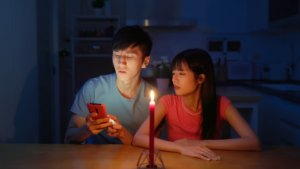 Knowing how to prepare for a blackout helps you survive a disaster. But knowing what to do afterward helps you get safely back on your feet. There are dangers even after the lights come on. They may not be as big, but they can certainly cause plenty of headaches. So before you breathe a sigh of relief, make sure you know what to do after a power outage.
Knowing how to prepare for a blackout helps you survive a disaster. But knowing what to do afterward helps you get safely back on your feet. There are dangers even after the lights come on. They may not be as big, but they can certainly cause plenty of headaches. So before you breathe a sigh of relief, make sure you know what to do after a power outage.
Put Out Candles and Kerosene Lamps
Candles and kerosene aren’t the best way to light your home during a blackout, but they are economical. However, open flames are a fire hazard, so if you have to use them, make sure they’re extinguished as soon as the power comes back. It’s easy to overlook them in the excitement and the last thing you want is someone knocking them over and causing another disaster.
Plug In Appliances One at a Time
Power surges often occur when the current is suddenly restored, which is why it’s a smart idea to unplug your electronics during a blackout. The rush of electricity can damage their circuitry. Re-connecting them all at once can create the same effect, so after the power’s restored, wait a few minutes before plugging them in. Start with your essential devices and work your way up to the less important ones.
Check Your Food
It isn’t safe to store foods at temperatures above 40°F. Bacteria can form in as little as three hours. Keeping your refrigerator closed will help safeguard it for a short time, but without power, most fridges warm up in about four hours. Fortunately, most modern fridges have a temperature display inside or outside, so you can tell right away whether your food was exposed to unsafe temperatures. One thing to remember: never taste food to see if it’s gone bad. If you have any doubts, throw it out. This includes:
- Meat, poultry, and seafood
- Soft and shredded cheese
- Dairy products, such as milk, cream, and yogurt
- Opened baby formula
- Eggs
- Dough and cooked pasta
- Chopped, cooked, or peeled produce
However, some foods are safe to keep, even after three or more hours. Feel free to eat:
- Hard cheeses
- Butter and margarine
- Tinned fruit
- Fruit juice
- Condiments, such as peanut butter, jelly, mustard, ketchup, relish, and salsa
- Pickles and olives
- Worcestershire, soy, and barbeque sauce
- Vinegar and salad dressing
- Bread, rolls, cakes, and pies
- Raw, uncut fruits and vegetables
Reset Your Clocks and Home Systems
Nowadays, the only clocks in your house that need to be reset after a power outage are probably the ones on your stove and microwave. Routers may need to be unplugged and restarted as well. If you used the manual release on your garage door, you may need to reconnect the remote control to get it working again. Consult your owner’s manual if you don’t know the steps.
It’s also possible the circuits in your HVAC system got overloaded when the power was restored and have to be reset. Though it sounds complex, the process is quite simple and can be done on your own. First, turn off your thermostat. Then go to your breaker box and cut the power to your furnace or air conditioner.
Wait sixty seconds, then flip it back on again. Don’t switch your thermostat on right away though. The circuits in your climate systems need time to realign, so wait another half hour before reactivating your thermostat and setting the temperature.
Look For Debris Outside
If the power outage happened because of a storm, it’s a good idea to check for debris around your home. Leaves, branches, and even entire trees might have been knocked over. However, downed power lines are a bigger concern. If you find one, call the power company immediately and stay at least fifty feet away to avoid being shocked.
Check For Exposed Outlets
Make sure your outside outlets are still covered and dry. Water and electricity don’t mix, so if you find one that’s been exposed to rain or snow, call an electrician to come have a look at it. The entire thing may have to be replaced before it’s safe to use it again.
Call Your Friends, Family, and Neighbors
Depending on how prepared you are, a blackout is either an inconvenience or an emergency, which is why it’s always good to check on the people close to you after a power outage. Make sure they’re okay and offer help if they’re struggling to get their home working again.
Protect Your Electrical System
Blackouts aren’t only stressful for you, but for your internal wiring as well. Power surges wear down your electrical system, contributing to future breakdowns. Repairing damaged wires can be costly, but signing up with Agway protects you from these types of expenses.
Every customer who joins is automatically enrolled in our EnergyGuardTM program, which covers your heating, cooling, and electrical systems. While other homeowners have to shoulder these costs themselves, our customers don’t. We hire an electrician and pay to repair and replace all covered parts on their behalf. There are no service fees or deductibles. Your coverage is included as part of our low monthly rates. So don’t get caught paying out of pocket. Sign up today!